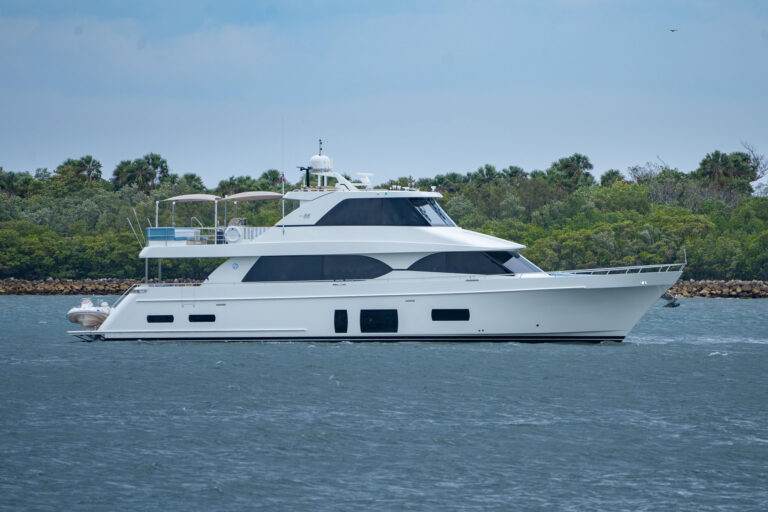Given the financial and emotional investment most of us have in our boats, feelings of anxiety about what’s happening to them when we aren’t aboard are easy to understand. If you’re the type who goes back to the boat to check things even if the trip takes hours from your otherwise busy schedule, you might consider Beacon Wireless Solutions’ new HarborMaster Mark II, a comprehensive two-way security monitoring and control system.
Any monitoring system faces at least two significant challenges: having a reliable method of communicating with the outside world, and offering reasonable certainty that someone will act on the problems reported. Many boat monitors communicate via a dedicated landline phone connection and are therefore useful only at the boat’s home dock. Some use a conventional cellular telephone, with its attendant monthly service charge and the possibility that the service may not work in the next port visited.
In both instances, the systems simply call one or two programmed phone numbers to alert someone that an alarm has been triggered.
The HarborMaster’s innovative two-way cellular communication channel, provided by the Aeris Microburst network (www.aeris.net), eliminates typical cellular glitches. This channel does not carry voice messages and, therefore, is lightly used, eliminating nearly all of the “busy channel problems encountered on some cellular sites. It can handle data packets of up to 100 bits (a microburst), which, with digital encoding, is sufficient to convey all of the system’s information.
The special cellular phone contained in the HarborMaster does not require a service contract with a local provider, eliminating the normal monthly service charge. Agreements between Aeris and the various cellular providers along the U.S. and Canadian coasts and at many locations on the Mexican coast ensure the HarborMaster’s ability to roam on various cellular networks. (At this time, service is not available in the Caribbean.)
In addition, the system is bi-directional, allowing the onboard monitor to receive the system manager’s or boat owner’s commands. This makes it possible to arm or disarm portions of the HarborMaster, such as the intrusion alarm, while not on board.
Information transmitted from the HarborMaster is sent to the Beacon Wireless Solutions alarm notification center in Toronto. The center’s computers notify the boat owner with a previously arranged sequence of calls that can include six separate addresses. Messages can be directed to home, office or cellular telephone; to a pager or other digital device; and into e-mail.
Boat owners can program the entire process via personal HarborMaster password-protected Web pages at www.beaconmarine.com. The pages show the status of the monitoring system and allow users to download and print all the data. Being able to inquire into the status of the boat via the Internet can be of particular value for owners who travel extensively outside North America.
Owners also can check the integrity of the cellular connection prior to leaving the boat. A backup alarm will function if a cellular call acknowledgement is not received after three attempts. The backup circuit can power a deck-mounted strobe light, an alarm bell or both for one hour to attract the attention of nearby personnel.
The system accepts information from as many as 12 sensors. These are high water, primary and secondary battery voltage, AC power status, two intrusion alarms, primary and secondary bilge pumps (cycles and duration per cycle), fire/smoke alarm, ignition switch on, low internal backup battery voltage, and an additional closed-loop sensor. Parameters can be programmed to suit the boat’s characteristics.
The HarborMaster also maintains a routine record of activity, such as bilge pump operating cycles, pump operating time, AC power status and battery voltage, with data downloaded to the system’s Web page on a scheduled or on-demand basis. This is good insurance in addition to the HarborMaster’s ability to report the application of power to an engine and the GPS-derived location of the boat if it moves from its normal location.
Normally powered from the boat’s DC system, the HarborMaster relies on six alkaline C-cells as a backup power source. Failure of the shorepower supply or the boat’s DC system will not go unannounced. Operational status appears on a 3 1/2 by 2 1/2-inch LCD that owners control via a six-button keypad and mouse, though some of the status announcements may be a challenge to read because of the small typeface.
Anyone comfortable with wiring low-voltage DC circuits should be able to install the HarborMaster. A bulkhead-mounted plastic housing measuring only 8 7/16 by 5 1/2 by 2 7/16 inches contains the entire package. Additional equipment includes a quarter-wavelength cellular antenna, a cable, a bilge-level float switch, an AC/DC shorepower monitor sensor, two magnetic hatch intrusion-detection switches, and 6-volt and 12-volt relays intended to be mounted separately from the monitor unit.
A remote-mounting LED indicates that the system is armed, and owners get two key-tag radio controls for arming and disarming the intrusion alarm.
The HarborMaster sells for about $900. Monthly monitoring fees vary depending on how many messages are exchanged. A fee of $25 per month covers the basic service, up to 10 messages per month, with additional messages charged at $1 each. Another $10 allows for 30 additional messages, surely enough to satisfy even the most lonely boat owner. For the very paranoid, additional messages of more than 40 are charged at 75 cents each. A message may consist of transmission and acknowledgement of an alarm, a routine statistics report (continuity of AC power, bilge pump operation data, battery voltage history, etc.) or a two-way request, such as deactivating the intrusion alarm so people can enter the boat.
As is usual with most wireless service systems, this one has a one-time activation fee of $25. The $300 annual cost of the basic service contract seems quite reasonable, and is really cheap if it eliminates a few return trips to the boat to assuage that nagging doubt late at night.
Contact: Beacon Wireless Solutions, www.beaconmarine.com.









